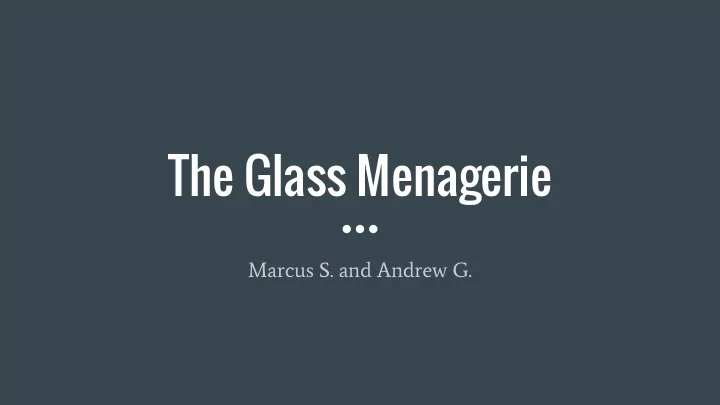

The Glass Menagerie Marcus S. and Andrew G.
Character Relations 4 person play, with 5 total characters Lack of many characters creates a need for well developed, well related characters Williams used a small cast list in order to allow for the audience to know all characters in detail This allows the audience to develop emotion for the characters
Imagery Unicorn acts as a foil to Laura Jim breaks its horn making it “like a normal horse” Jim also brings Laura out of her shyness The unicorn acts as a physical foil to the metaphysical aspects of Laura’s character
Music Music is used to enhance the drama within The Glass Menagerie Occurs inside and outside of the play itself Provides commentary on events within play The musical piece “The Glass Menagerie” occurs multiple times without the characters being able to hear it Introduced at the end of scene 1, when Laura is afraid she’ll end up alone https://www.youtube.com/watch?v=pKI49JfNPNc The focus on music helps guide the play and cues the audience on the dramatic events
Ecocriticism Ecocriticism is the usage of setting and scenery to affect the mood of a literal work The setting of The Glass Menagerie is St Louis, 1937, mainly within the limited confines of an apartment The apartment is small, and sets a limit to the distance the characters can keep each other at, meaning that the living space in which the characters abide keeps all the various entities very close to each other and creating a high conflict setting. Consider how the size and geography of the play’s setting affected the play and how changes in these aspects may have affected the plot
Gender Studies Focuses on how characters relate to the masculine/feminine binary Amanda Stereotypical southern belle Abandoned by husband Decides to raise two children on her own Focused on giving the best to children, not being girly Typically “masculine” traits, active and powerful Laura Very shy
Moral Critical Lens Analyzing a character's moral decisions and standpoints as a form of interpreting the author’s choices and the intent. Amanda- Within the play Amanda often makes selfish decisions due to her own preconceived ideas of how things work, such as expecting Tom to pay for her and Laura’s lives while still assuming authority in a house she has not earned Tom- Tom is morally torn between altruism and self interest, he knows he has to provide for his family, but sacrifices what he desires to do so, and pursuing his own personal interests would jeopardize his family. When using Moral Critical Lenses it is important to understand that moral decisions stand out by how they relate to the critiques individual moral standpoints In what ways does the conflicting moral understanding of each character's moral standpoints reflect on the message of the play
Recommend
More recommend